| |
|
An Illustrated History of Chess_________________10___
Game
lovers will never stop dreaming up new versions of chess. To quote
D.B. Pritchard, author of The Encyclopedia of Chess Variants,
"Anyone can invent a new chess variant within ten seconds
(try it) and unfortunately some people do."
The point is this: it's easy to think "what if...the
board were bigger, smaller, differently shaped; what if there
were more players, more pieces, more moves..." but it is
not so easy to invent a game, based on chess, which has merit
in itself...and which many people might actually enjoy playing.
Pritchard's encyclopedia includes some 160 variants — and
claims to have excluded hundreds more, which the author considered
less worthy. Let's glance at just a few interesting chess variants,
to stimulate the imagination...
|
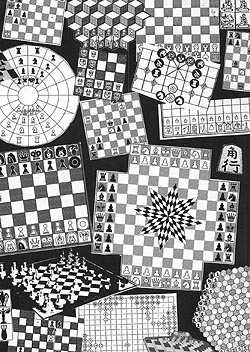
from the cover of The
Encyclopedia of Chess Variants, by D.B. Pritchard |
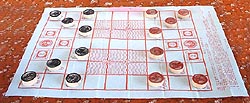
dou shou qi |
Here is a Chinese game, dou shou qi ("doe show chee"),
meaning "fighting animal game."
 It seems to be a children's
variant of Chinese chess, and has been around for at least a century.
The pieces represent animals: the bigger ones eat the smaller ones,
in a quest to enter the opponent's den (like the Chinese chess fortress).
It seems to be a children's
variant of Chinese chess, and has been around for at least a century.
The pieces represent animals: the bigger ones eat the smaller ones,
in a quest to enter the opponent's den (like the Chinese chess fortress).
Interestingly, dou shou qi has many similarities to the popular
game Stratego, and it is widely supposed that Stratego evolved from
this game. |
| One
of the most popular American chess variants is from the early seventies,
Smess ... as in the deriding rhyme "chess
— smess!" The interesting change here is that the
squares of the board — not the identity of the different pieces
— define the direction of the pieces' moves. Easy to learn,
and interesting in the unique complexities it offers. |

Smess
|
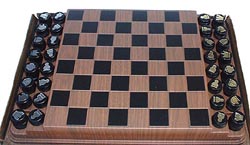
Neo-Chess
|
Neo
Chess is an obvious enough variant. It is played like western
chess, but adds the possibility of placing captured pieces back
in play — something borrowed directly from the Japanese
chess, shogi.
|
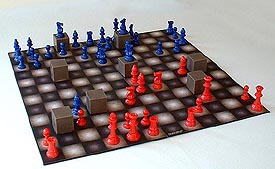
Shuuro,
a new chess variant played on a 12 x 12
board with obstacle blocks
|
And
here's a new variant with several interesting features. Shuuro
is played on a large 12 x 12 board, with randomly placed blocks
to alter the landscape. The two armies are various combinations
of pieces are set up in an array chosen by the players before the
moves commence. Fascinating changes, but easy for the standard chess
player to grasp, since the pieces move in the ways that we are used
to. |
And who says chess has to be played on squares? This is just one
of many variants which try spaces of a different shape. Hexes
is played on hexagons, and the moves of the pieces are adapted as
logically as possible to the game's altered geometry. Note that
three different colors of playing spaces are present, and each side
has 3 bishops — one to command each color.
|
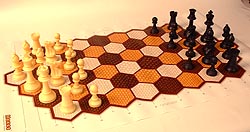
Hexes |
I hope you've enjoyed this brief romp through the world of chess,
and that it has stimulated your curiosity. If so, please investigate
some of the links found on the links
page to take your investigation further. Playing
sets for the variants discussed here are available through
this web site, as are the rules of play for
several variants. It is a pleasure to share this special passion
for chess history and evolution. Drop us an email,
if you have a moment, with questions, corrections, or enthusiastic
exclamations of any kind.
<<Previous
Page ... The Games >>
|
__
|
|






